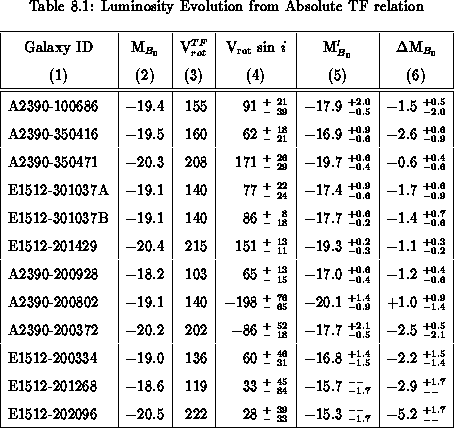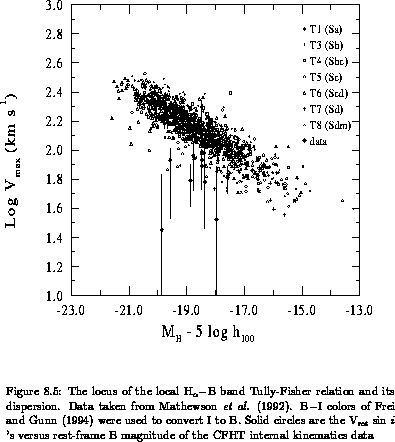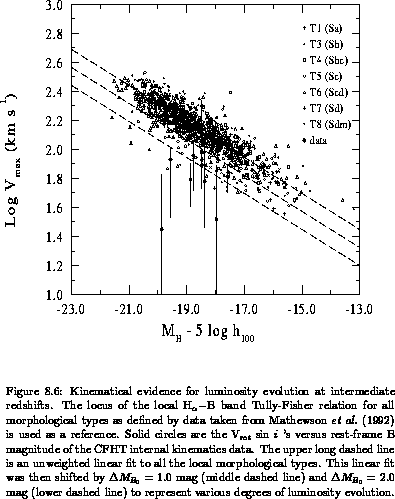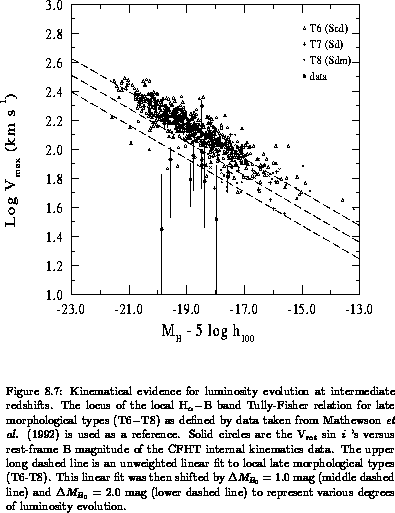Kinematical Evidence for Luminosity Evolution




Next: Comparison with Other
Up: Discussion
Previous: Morphological Dependence of
As discussed in section  , one can compare the internal kinematics of intermediate redshift galaxies with the local Tully-Fisher to look for kinematical evidence for luminosity evolution. Figure
, one can compare the internal kinematics of intermediate redshift galaxies with the local Tully-Fisher to look for kinematical evidence for luminosity evolution. Figure  shows the CFHT internal kinematics results with respect to the absolute calibration of the Tully-Fisher relation [\protect\astroncitePierce and Tully1992] converted to H
shows the CFHT internal kinematics results with respect to the absolute calibration of the Tully-Fisher relation [\protect\astroncitePierce and Tully1992] converted to H velocities as explained in section
velocities as explained in section  . All data points except one appear to lie systematically below the local TF relation for edge-on galaxies. 9 out of 12 galaxies lie below the expected relation for randomly oriented disks. The relation would have to be shifted to brighter magnitudes to lie on top of the internal kinematics measurements. The target galaxies are too bright for their mass, as one would expect from luminosity
. All data points except one appear to lie systematically below the local TF relation for edge-on galaxies. 9 out of 12 galaxies lie below the expected relation for randomly oriented disks. The relation would have to be shifted to brighter magnitudes to lie on top of the internal kinematics measurements. The target galaxies are too bright for their mass, as one would expect from luminosity dependent luminosity evolution. Number counts and redshift studies are unable to differentiate between density and luminosity evolution to explain the increase in the Schechter normalization
dependent luminosity evolution. Number counts and redshift studies are unable to differentiate between density and luminosity evolution to explain the increase in the Schechter normalization  , since to increase
, since to increase  , one can either increase the number of galaxies or increase the luminosity of existing galaxies to L
, one can either increase the number of galaxies or increase the luminosity of existing galaxies to L . Figure
. Figure  is clear evidence that luminosity is the evolving variable in these intermediate redshift galaxies.
is clear evidence that luminosity is the evolving variable in these intermediate redshift galaxies.
Table  lists the change in absolute magnitude
lists the change in absolute magnitude  M
M for each of the 12 kinematically normal galaxies plotted in Figure
for each of the 12 kinematically normal galaxies plotted in Figure  . Column 3 gives the H
. Column 3 gives the H rotation velocity expected for a galaxy with M
rotation velocity expected for a galaxy with M given in Column 2 based on the Pierce and Tully pierce92 TF calibration. Column 5 gives the absolute B magnitude M
given in Column 2 based on the Pierce and Tully pierce92 TF calibration. Column 5 gives the absolute B magnitude M of a galaxy with V
of a galaxy with V sin
sin  given in Column 4 based on the same TF calibration. Column 6 gives the change in absolute magnitude
given in Column 4 based on the same TF calibration. Column 6 gives the change in absolute magnitude  M
M = M
= M
 M
M . There is a wide range of
. There is a wide range of  M
M , but
, but  M
M appears to be
appears to be  1.8 mag on average. Interestingly enough, the luminosity evolution scenario of Broadhurst et al. broad88 needed
1.8 mag on average. Interestingly enough, the luminosity evolution scenario of Broadhurst et al. broad88 needed  M
M = +2.2 mag of fading to explain the excess of field galaxies seen at z
= +2.2 mag of fading to explain the excess of field galaxies seen at z  0.4 over no-evolution number counts based on the Loveday et al. loveday92 LF.
0.4 over no-evolution number counts based on the Loveday et al. loveday92 LF.

Another aspect of the Broadhurst et al. broad88 was the dependence of  M
M on the gas content of galaxies (Section
on the gas content of galaxies (Section  ). Low-luminosity (i.e. low mass), gas-rich galaxies underwent more luminosity evolution than brighter, relatively gas-poor ones. This led to a non-uniform brightening of the dwarf component of the galaxy population. This non-uniformity would have a direct influence on the slope of the TF relation at intermediate redshifts as massive galaxies would have smaller
). Low-luminosity (i.e. low mass), gas-rich galaxies underwent more luminosity evolution than brighter, relatively gas-poor ones. This led to a non-uniform brightening of the dwarf component of the galaxy population. This non-uniformity would have a direct influence on the slope of the TF relation at intermediate redshifts as massive galaxies would have smaller  M
M 's. Although the current sample is quite small, Figure
's. Although the current sample is quite small, Figure  offers tantalizing hints that such a non-uniform luminosity evolution is indeed occurring. The two galaxies with V
offers tantalizing hints that such a non-uniform luminosity evolution is indeed occurring. The two galaxies with V sin
sin 
 175 km/s and M
175 km/s and M

 20.4 are at least near the dashed line. Galaxies with V
20.4 are at least near the dashed line. Galaxies with V sin
sin  < 100 km/s have larger and more spread out
< 100 km/s have larger and more spread out  M
M values even though these galaxies roughly have the same mass. It therefore seems that low-mass galaxies are more affected by whatever process is causing luminosity evolution at those redshifts (see Section
values even though these galaxies roughly have the same mass. It therefore seems that low-mass galaxies are more affected by whatever process is causing luminosity evolution at those redshifts (see Section  for further discussion). A larger sample is needed to study <
for further discussion). A larger sample is needed to study < M
M > and
> and  (
( M
M ) as function of redshift and galaxy mass.
) as function of redshift and galaxy mass.
It is impossible to tell from Figure  how much the scatter in the local TF relation might contribute to
how much the scatter in the local TF relation might contribute to  M
M . To solve this problem, the CFHT internal kinematics data were plotted against the Mathewson et al. mathew92 TF relation shown in Figure
. To solve this problem, the CFHT internal kinematics data were plotted against the Mathewson et al. mathew92 TF relation shown in Figure  . The result is shown in Figure
. The result is shown in Figure  . V
. V sin
sin  's were taken from Table
's were taken from Table  , and M
, and M magnitudes were taken from Table
magnitudes were taken from Table  . Since these magnitudes had been computed using H
. Since these magnitudes had been computed using H = 75, they were shifted by +0.62 mag before they were plotted on Figure
= 75, they were shifted by +0.62 mag before they were plotted on Figure  . The internal kinematics data clearly lie below the centroid of the Mathewson et al. relation. Part of the difference comes from the fact that the rotation velocities V
. The internal kinematics data clearly lie below the centroid of the Mathewson et al. relation. Part of the difference comes from the fact that the rotation velocities V given by Mathewson et al. are for edge-on galaxies whereas the internal kinematics data have not been inclination-corrected. For randomly-oriented disks, the Mathewson et al. relation would shift downwards by 0.1 in log V
given by Mathewson et al. are for edge-on galaxies whereas the internal kinematics data have not been inclination-corrected. For randomly-oriented disks, the Mathewson et al. relation would shift downwards by 0.1 in log V (<V
(<V > = 0.7854 <V
> = 0.7854 <V >). The correction to the Mathewson et al. relation is likely to be smaller since target galaxies with elongated CNOC MOS images have been preferentially selected.
>). The correction to the Mathewson et al. relation is likely to be smaller since target galaxies with elongated CNOC MOS images have been preferentially selected.
Even if the Mathewson et al. relation is shifted downwards by a full 0.1 in log V , the internal kinematics data points still lie below the centroid of the relation. To illustrate the size of the discrepancy, an unweighted linear fit was made to the data for all morphological types in the Mathewson et al. relation. After three 3
, the internal kinematics data points still lie below the centroid of the relation. To illustrate the size of the discrepancy, an unweighted linear fit was made to the data for all morphological types in the Mathewson et al. relation. After three 3 -clipping rejection iterations, the fit converged to
-clipping rejection iterations, the fit converged to

The uncertainty on the coefficients are formal 1 errors. This fit was then shifted in M
errors. This fit was then shifted in M by
by  1.0 and
1.0 and  2.0 mag. The result are the three dashed lines shown in Figure
2.0 mag. The result are the three dashed lines shown in Figure  . The
. The  M
M =
=  2.0 mag line appears to be closer to the data points in agreement with the amount of luminosity evolution estimated using Pierce and Tully pierce92 TF calibration. However, it is immediately obvious that the TF envelope of local late-type galaxies (Scd-Sm) reaches down as far as most of the internal kinematics data points. According to Frei and Gunn frei94's tables, the target galaxies have colors typical of Scd-Sdm galaxies, so a comparison with a subset of the Mathewson et al. sample comprising only late-type (T6-T8) might be more appropriate. The result is shown in Figure
2.0 mag line appears to be closer to the data points in agreement with the amount of luminosity evolution estimated using Pierce and Tully pierce92 TF calibration. However, it is immediately obvious that the TF envelope of local late-type galaxies (Scd-Sm) reaches down as far as most of the internal kinematics data points. According to Frei and Gunn frei94's tables, the target galaxies have colors typical of Scd-Sdm galaxies, so a comparison with a subset of the Mathewson et al. sample comprising only late-type (T6-T8) might be more appropriate. The result is shown in Figure  . After three 3
. After three 3 -clipping rejection iterations, an unweighted linear fit converged to
-clipping rejection iterations, an unweighted linear fit converged to

The TF late-type relation is not systematically different from the global one since Equations  and
and  have the same slopes and the same intercepts (within the uncertainty).
have the same slopes and the same intercepts (within the uncertainty).



The scatter in the Tully-Fisher shown in Figures  and
and  comes from three sources: internal absorption, galaxy peculiar velocities and variations in star formation rates. The Mathewson et al. catalog does list total magnitudes corrected for internal absorption. These magnitudes were not used because the absolute magnitudes of the galaxies in the CFHT sample were not corrected for internal absorption. The effect of galaxy peculiar velocities is minor. Peculiar velocities lead to
comes from three sources: internal absorption, galaxy peculiar velocities and variations in star formation rates. The Mathewson et al. catalog does list total magnitudes corrected for internal absorption. These magnitudes were not used because the absolute magnitudes of the galaxies in the CFHT sample were not corrected for internal absorption. The effect of galaxy peculiar velocities is minor. Peculiar velocities lead to  10
10 errors on galaxy distances. The major unknown is star formation. The existing body of local Tully-Fisher data is insufficient to ascertain the dependence of local galaxy luminosity on the strengths of emission lines indicative of star formation. In order to accurately measure magnitude offsets from the Tully-Fisher relation, each galaxy in the CFHT sample (or any other sample for that matter) should be compared to the local Tully-Fisher relation for galaxies with similar [OII] emission line strengths. This is not possible for now. A large, homogeneous sample of local emission-line strengths, rotation velocities, morphologies and absolute magnitudes is required to settle this issue. This will remain a major limitation of internal kinematics studies at high redshifts as long as technical requirements restrict them to strong emission-line objects.
errors on galaxy distances. The major unknown is star formation. The existing body of local Tully-Fisher data is insufficient to ascertain the dependence of local galaxy luminosity on the strengths of emission lines indicative of star formation. In order to accurately measure magnitude offsets from the Tully-Fisher relation, each galaxy in the CFHT sample (or any other sample for that matter) should be compared to the local Tully-Fisher relation for galaxies with similar [OII] emission line strengths. This is not possible for now. A large, homogeneous sample of local emission-line strengths, rotation velocities, morphologies and absolute magnitudes is required to settle this issue. This will remain a major limitation of internal kinematics studies at high redshifts as long as technical requirements restrict them to strong emission-line objects.




Next: Comparison with Other
Up: Discussion
Previous: Morphological Dependence of
Luc Simard
Mon Sep 2 12:37:40 PDT 1996
 velocities as explained in section
velocities as explained in section  dependent luminosity evolution. Number counts and redshift studies are unable to differentiate between density and luminosity evolution to explain the increase in the Schechter normalization
dependent luminosity evolution. Number counts and redshift studies are unable to differentiate between density and luminosity evolution to explain the increase in the Schechter normalization  , since to increase
, since to increase  , one can either increase the number of galaxies or increase the luminosity of existing galaxies to L
, one can either increase the number of galaxies or increase the luminosity of existing galaxies to L . Figure
. Figure  M
M for each of the 12 kinematically normal galaxies plotted in Figure
for each of the 12 kinematically normal galaxies plotted in Figure  rotation velocity expected for a galaxy with M
rotation velocity expected for a galaxy with M of a galaxy with V
of a galaxy with V sin
sin  given in Column 4 based on the same TF calibration. Column 6 gives the change in absolute magnitude
given in Column 4 based on the same TF calibration. Column 6 gives the change in absolute magnitude  1.8 mag on average. Interestingly enough, the luminosity evolution scenario of Broadhurst et al. broad88 needed
1.8 mag on average. Interestingly enough, the luminosity evolution scenario of Broadhurst et al. broad88 needed 
 (
( = 75, they were shifted by +0.62 mag before they were plotted on Figure
= 75, they were shifted by +0.62 mag before they were plotted on Figure  given by Mathewson et al. are for edge-on galaxies whereas the internal kinematics data have not been inclination-corrected. For randomly-oriented disks, the Mathewson et al. relation would shift downwards by 0.1 in log V
given by Mathewson et al. are for edge-on galaxies whereas the internal kinematics data have not been inclination-corrected. For randomly-oriented disks, the Mathewson et al. relation would shift downwards by 0.1 in log V > = 0.7854 <V
> = 0.7854 <V >). The correction to the Mathewson et al. relation is likely to be smaller since target galaxies with elongated CNOC MOS images have been preferentially selected.
>). The correction to the Mathewson et al. relation is likely to be smaller since target galaxies with elongated CNOC MOS images have been preferentially selected.





 errors on galaxy distances. The major unknown is star formation. The existing body of local Tully-Fisher data is insufficient to ascertain the dependence of local galaxy luminosity on the strengths of emission lines indicative of star formation. In order to accurately measure magnitude offsets from the Tully-Fisher relation, each galaxy in the CFHT sample (or any other sample for that matter) should be compared to the local Tully-Fisher relation for galaxies with similar [OII] emission line strengths. This is not possible for now. A large, homogeneous sample of local emission-line strengths, rotation velocities, morphologies and absolute magnitudes is required to settle this issue. This will remain a major limitation of internal kinematics studies at high redshifts as long as technical requirements restrict them to strong emission-line objects.
errors on galaxy distances. The major unknown is star formation. The existing body of local Tully-Fisher data is insufficient to ascertain the dependence of local galaxy luminosity on the strengths of emission lines indicative of star formation. In order to accurately measure magnitude offsets from the Tully-Fisher relation, each galaxy in the CFHT sample (or any other sample for that matter) should be compared to the local Tully-Fisher relation for galaxies with similar [OII] emission line strengths. This is not possible for now. A large, homogeneous sample of local emission-line strengths, rotation velocities, morphologies and absolute magnitudes is required to settle this issue. This will remain a major limitation of internal kinematics studies at high redshifts as long as technical requirements restrict them to strong emission-line objects.